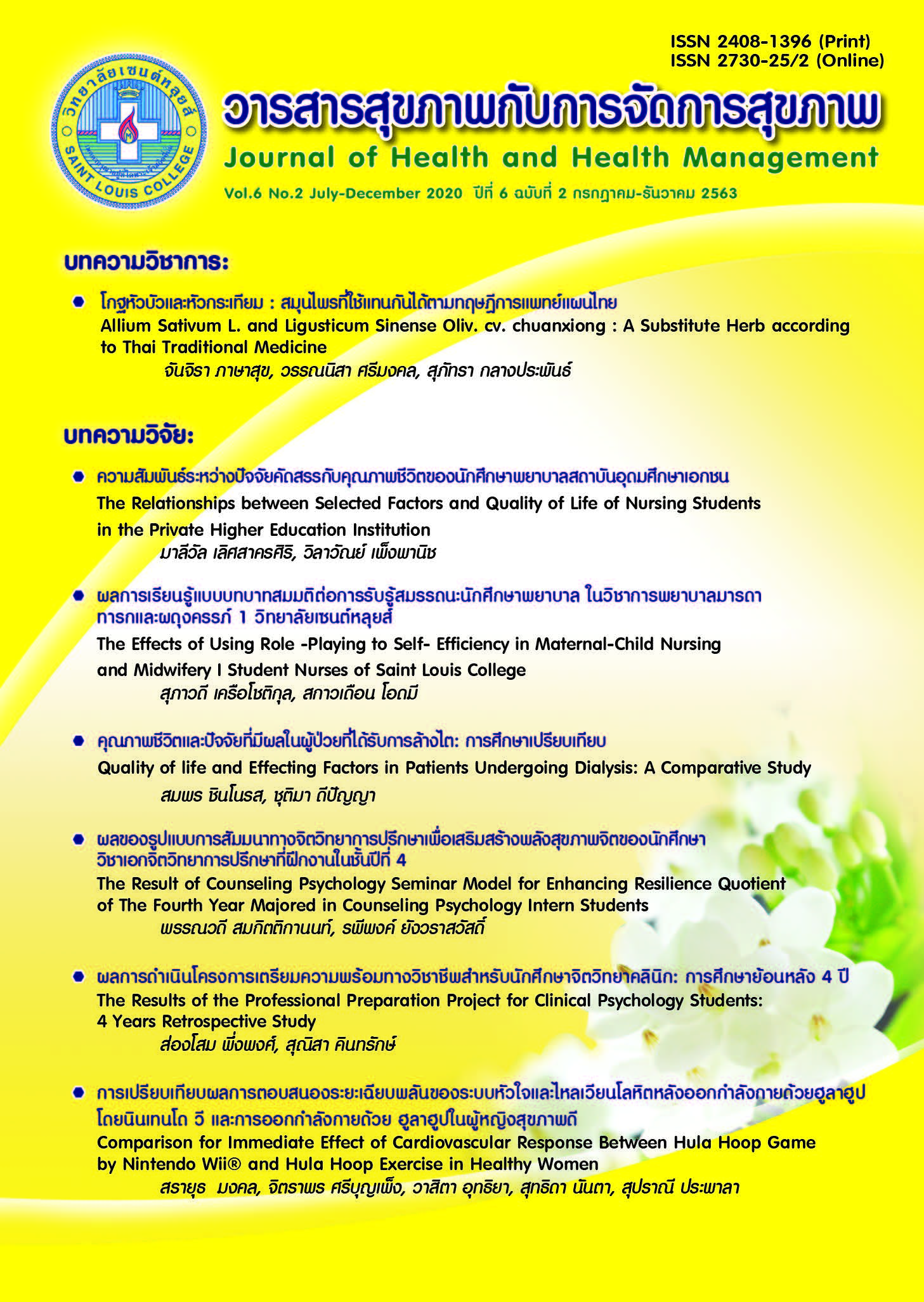Allium Sativum L. and Ligusticum Sinense Oliv. cv. chuanxiong : A Substitute Herb according to Thai Traditional Medicine
Keywords:
Allium Sativum L., Ligusticum sinense Oliv. cv. chuanxiong, Substitute HerbsAbstract
According to Thai traditional medicine, Allium sativum L. can be used as a substitute for Ligusticum sinense Oliv. cv. chuanxiong. Due to costly to import. The literature review on medicinal properties, chemical composition and pharmacological activity found that A. sativum L. and L. sinense Oliv. cv. chuanxiong are comprised some of the same major groups of phytochemicals, Essential oil. L. sinense Oliv. cv. Chuanxiong contains Anhydride, Phenolic acids and Phthalide lactones, while garlic contains Sulfur. Although the use of Thai traditional medicine textbooks, both of herbs have properties for carminative. They have pharmacological effects of antioxidant and anti-inflammatory as well. However, the literature review found that such pharmacological effects were due to different chemical constituents. So if you want to use both of these herbs are substitute herb, there should be a comparative study of the chemical composition and pharmacological activities of the two herbs to support a substitute of herb.
References
คณะกรรมการคุ้มครองและส่งเสริมภูมิปัญญาการแพทย์แผนไทย. (2552). ตำราอ้างอิงยาสมุนไพรไทย เล่ม 1. เฉลิมพระเกียรติพระบาทสมเด็จพระเจ้าอยู่หัว เนื่องในมหามงคลสมัยที่ทรงครองสิริราชสมบัติครบ 60 ปี, พิมพ์ครั้งที่ 1. กรุงเทพมหานคร: บริษัทอมรินทร์พริ้นติ้งแอนด์พับลิชชิ่ง จำกัด (มหาชน).
จันคนา บูรณะโอสถ, ปนัดดา พัฒนวศิน, ภัทราวดี เหลืองธุวปราณีต, ปกรณ์ คามวุฒิ และอุทัย โสธนะพันธุ์. (2559). การวิเคราะห์หาองค์ประกอบของสารหอมระเหยจากเครื่องยาในพิกัดเนาวโกฐด้วยวิธีโครมาโท-กราฟีแบบแก๊ส-แมสสเปกโทรเมทรี. ไทยไภษัชยนิพนธ์, 11(2), 45-60.
จันทร์กระจ่าง สีห์สรรพสวัสดิ์. (2546). สมุนไพรไทยมรดกจากบรรพชน. พิมพ์ครั้งที่ 1. กรุงเทพมหานคร:สำนักพิมพ์ภูมิปัญญา.
ชยันต์ พิเชียรสุนทร, ศุภชัย ติยวรนันท์ และวิเชียร จีรวงส์. (2555). คู่มือเภสัชกรรมไทย เล่ม 6. พิมพ์ครั้งที่ 1. กรุงเทพมหานคร: สำนักพิมพ์อมรินทร์.
ภรภัทร ตั้งงวรกิตติ์ และรังสินี โสธรวิทย์. (2554). ปัจจัยที่มีผลต่อสมบัติการต้านอนุมูลอิสระและสมบัติ การต้านเชื้อแบคทีเรียของสารสกัดจากกระเทียม. การประชุมวิชาการ ครั้งที่ 8, มหาวิทยาลัยเกษตรศาสตร์วิทยาเขตกำแพงแสน จ.นครปฐม.
วุฒิ วุฒิธรรมเวช. (2537). ยาสมุนไพรในสาธารณสุขมูลฐาน. พิมพ์ครั้งที่ 1. โรงพิมพ์องค์การสงเคราะห์ทหารผ่านศึก.
Bozin, B., Mimica-Dukic, N., Samojlik, I., Goran, A., & Igic, R. (2008). Phenolics as antioxidants in garlic (Allium sativum L., Alliaceae). Food chemistry, 111(4), 925-929.
Chang, X.L., Jiang, Z.Y., Ma, Y.B., Zhang, X.M., Tsim, K.W., & Chen, J.J. (2009). Two new compounds from the roots of Ligusticum chuanxiong. Journal of Asian natural products research, 11(9), 805-810.
Chang, X.L., Ma, Y.B., Zhang, X.M., Jiang, Z.Y., & Chen, J.J. (2007). Studies on chemical constituents of rhizomes of Ligusticum chuanxiong. Journal of Chinese materia medica, 32(15), 1533-1536.
Department of Medical Sciences, Ministry of Public Health. Thai Herbal Pharmacopoeia 2019. Volume II. Bangkok: The Agricultural Co-operative Federation of Thailand.,Ltd; 2019.
Eidi, A., Eidi, M., & Esmaeili, E. (2006). Antidiabetic effect of garlic (Allium sativum L.) in normal and streptozotocin-induced diabetic rats. Phytomedicine, 13(9-10), 624-629.
Huang, J., Lu, X.Q., Zhang, C., Lu, J., Li, G.Y., Lin, R.C., & Wang, J.H. (2013). Anti-inflammatory ligustilides from Ligusticum chuanxiong Hort. Fitoterapia, 91, 21-27. doi: 10.1016/j. fitote.2013.08.013.
Lawal, B., Shittu, O.K., Oibiokpa, F.I., Mohammed, H., Umar, S.I., & Haruna, G.M. (2016). Antimicrobial evaluation, acute and subacute toxicity studies of Allium sativum. Journal of Acute Disease, 5(4), 296-301.
Lawson, L.D., Wang, Z.Y.J., & Hughes, B.G. (1991). Identification and HPLC quantitation of the sulfides and dialk (en) yl thiosulfinates in commercial garlic products. Planta medica, 57(04), 363-370.
Liu, X., Li, X., Ji, S., Cui, X., & Li, M. (2016). Screening of bioactive ingredients in Ligusticum chuanxiong Hort for protection against myocardial ischemia. Cellular Physiology and Biochemistry, 40(3-4),770-780.
Prati, P., Henrique, C.M., Souza, A.S.D., Silva, V.S.N.D., & Pacheco, M.T.B. (2014). Evaluation of allicin stability in processed garlic of different cultivars. Food Science and Technology, 34(3), 623-628.
Ren, D.C., Yang, N.Y., Qian, S.H., Xie, N., Zhou, X.M., & Duan, J.A. (2007). Chemical study on aerial parts of Ligusticum chuanxiong. Journal of Chinese materia medica, 32(14), 1418.
Ross, Z.M., O’Gara, E.A., Hill, D.J., Sleightholme, H.V., & Maslin, D.J. (2001). Antimicrobial properties of garlic oil against human enteric bacteria: evaluation of methodologies and comparisons with garlic oil sulfides and garlic powder. Applied and environmental microbiology, 67(1), 475-480.
Shao, X., Sun, C., Tang, X., Zhang, X., Han, D., Liang, S., & Fang, H. (2020). Anti-Inflammatory and Intestinal Microbiota Modulation Properties of Jinxiang Garlic (Allium sativum L.) Polysaccharides toward Dextran Sodium Sulfate-Induced Colitis. Journal of Agricultural and Food Chemistry, 68(44), 12295-12309.
Wei, Q., Yang, J., Ren, J., Wang, A., Ji, T., & Su, Y. (2014). Bioactive phthalides from Ligusticum sinense Oliv cv. Chaxiong. Fitoterapia, 93, 226-232.
Xiao, Y.Q., Li, L.I., You, X.L., Taniguchi, M., & Baba, K. (2002). Studies on chemical constituents of the rhizomae of Ligusticum chuanxiong. Journal of Chinese materia medica, 27(7), 519-522.
Yang, J., Feng, X.L., Yu, Y., Wang, Q., Zou, J., Wang, C.X., Mu, Z.Q., Yao, X.S., & Gao, H. (2016). Novel phthalide derivatives identified from Ligusticum chuanxiong. Chinese medicine, 11(1), 1-7. doi: 10.1186/s13020-016-0080-2.
Yuan, J.F., Zhang, Z.Q., Fan, Z.C., & Yang, J.X. (2008). Antioxidant effects and cytotoxicity of three purified polysaccharides from Ligusticum chuanxiong Hort. Carbohydrate Polymers, 74(4), 822-827.




